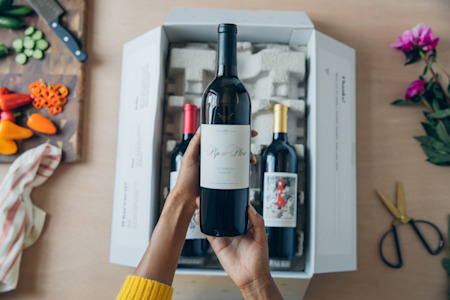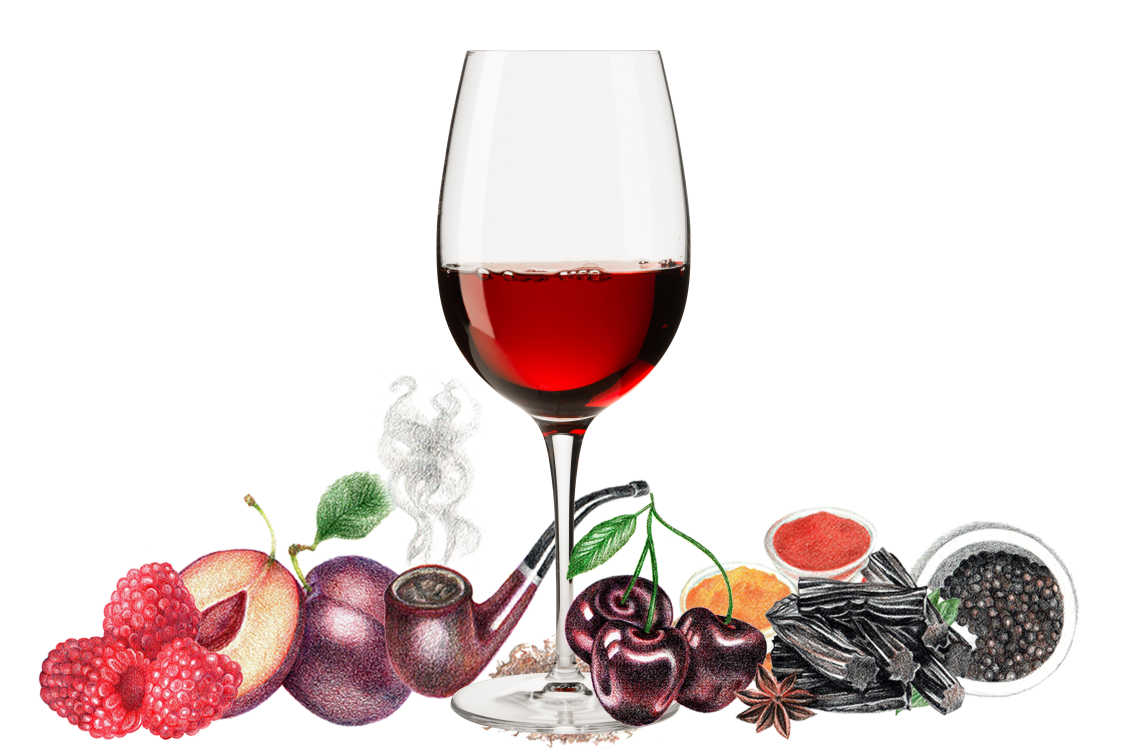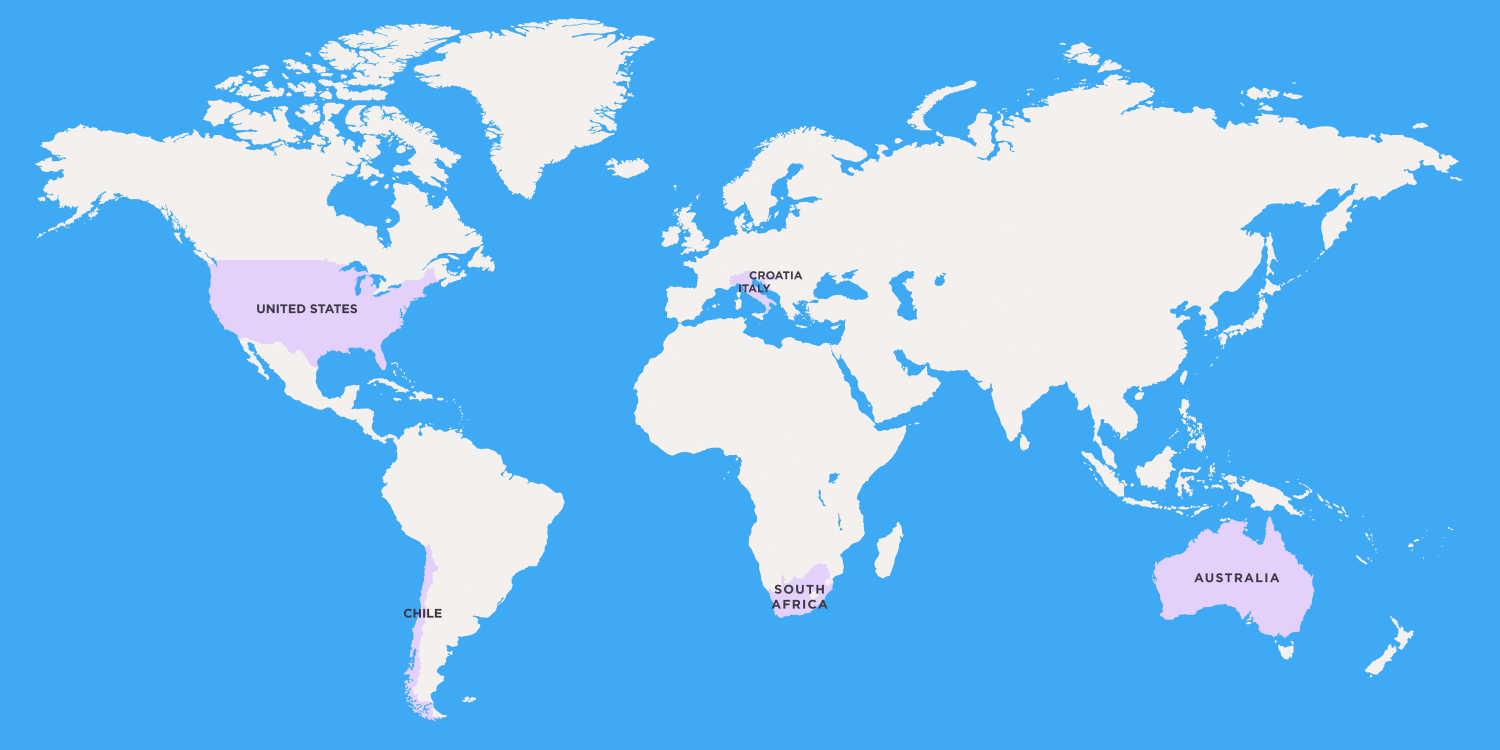Zinfandel
This richly flavored red wine is many wine drinkers go-to grape.
Zinfandel wine grapes were dying out. They were victims of being replanted and victims of neglect, at least until California Zinfandel caught on. Unlike many international wine varietals (Chardonnay, Merlot, and Cabernet Sauvignon) that enjoyed success in the Old World, Zinfandel, much like Malbec, is a New World hero.
Whether it is under the name Primitivo, White Zinfandel, or even Crljenak Kaštelanski, this richly flavored grape is many wine drinkers go-to selection. There is something bold and exciting about the fruit-forwardness and versatility of the wine. Despite being a red grape, Zinfandel can be used to make whatever style of wine the winemaker wants. They can quickly press grapes picked early to make the colorless and semi-sweet White Zinfandel. They can use a short amount of skin contact during maceration to make a blush wine (known as Pink Zinfandel). And there is always the traditional California favorite: old-vine, red Zinfandel.

Take Our Quiz Today
Get award-winning delicious wines from all over the world shipped straight to your door. Take the quiz to get the perfect pairings for your holiday season.
Take The Quiz TodayIN THIS ARTICLE:
Want personalized wines?
Get your first box of wines for $44.95 + free shipping.

History of Zinfandel
Zinfandel (pronounced zihn-fan-dell) has a story that tells itself backward. For many years the origins were unknown, it was considered a California grape. But through painstaking research by scientists at UC Davis we finally know where it came from.
The first mentions of Zinfandel were under a few slightly different names ("Zinfardel" and "Zinfindal") on the east coast of the United States in the middle of the 19th century. Regardless of the name, Zinfandel vines made their way to California with the Gold Rush and it has grown there ever since.
Carole Meredith, a noted grape geneticist at UC Davis wanted to know the origins of the grape, and through hard work and some happenstance was able to track down the origins of Zinfandel.
Using genetic testing she was able to determine that Italian Primitivo was actually the same grape, and by working with other scientists they were able to narrow down their search for the origins of the grape to the Dalmatian Coast of Croatia. By combing through many Croatian vineyards and testing the grapes she stumbled onto a once in a lifetime discovery: nine vines of Crljenak Kaštelanski growing in a field of thousands of other grapes that directly matched the genetic makeup of Zinfandel. The mystery was solved!
Since then clones of the original vines have been planted across vineyards in California. Some of the most well-known producers (including Ridge Vineyards) have taken an interest in the wine and produce incredible bottles.
What does Zinfandel taste like?
Zinfandel is a rich, fruit-forward wine. If picked early there are hints of blackberry, black cherry, plums, and red apple. Later picked Zinfandel is more overtly red-fruited with strawberry, cranberry, and raspberry notes filling out the profile. There is also a decent amount of spice naturally occurring in the wine and flavors like tobacco, anise, and pepper stand out among other secondary and tertiary flavors.
Zinfandel Characteristics
Zinfandel is a thin-skinned grape that grows in huge bunches on the vine. The best vineyard sites for Zinfandel are poorly drained hillsides that are rich in minerals. The thin skins means that they are low in tannin, and prone to uneven ripening. Most Zinfandel is picked with ripe and unripe grapes, meaning that many of the flavors from both ends of the Zinfandel spectrum are represented in many of the wines. Over-ripe examples typically taste jammy and are very high in alcohol, while unripe examples are acidic and contain more subtle blue fruit flavors.
For many years it was used as a field blending grape, but today it is often seen as a single varietal, whether it is a red, pink, or white wine. Many winemakers blend Zinfandel with just a touch of Petite Sirah to balance the body. It takes well to new and old oak, and in particular the rich vanilla and spice that come from American oak.
Fun Fact
White zinfandel sells six times as much as red.
Zinfandel Nutritional Facts
The nutritional value in Zinfandel varies greatly depending on two main factors: alcohol and sugar. The more sugar present in a wine, the more carbohydrates.
The alcohol in Zinfandel varies depending on how ripe the grapes were when harvested, if the winemaker added extra sugar, and how long it was allowed to ferment. Zinfandel wines are generally in the middle range for all of these categories, but ripe examples can be high in alcohol.
How to Serve and Store Zinfandel
Zinfandel is a wine that is not traditionally meant to age. The longer it spends aging, the more fruit, sweetness, and spice flavors are dulled. There are a few exceptions, but as with most other wines, Zinfandel is meant to be enjoyed fresh.
Serving Zinfandel can be done simply. The wine should be served at cellar temperature. If you want to experience the wine through multiple stages we recommend popping your wine in the refrigerator fifteen minutes to half an hour before serving and tasting as it warms in your glass, but this is all personal preference. Enjoy your wine how you like it.
To open you will need a traditional corkscrew.
If you are storing Zinfandel, it should be in a cool place that does not receive direct sunlight, and preferably in a wine refrigerator or cellar. 55 degrees Fahrenheit is the median temperature wine should be stored if you wish to age the bottles. What matters most is consistency. Do not store your Zinfandel in a place that receives direct sunlight, heat, or too much humidity and remember to enjoy it while it's fresh.
What to Pair with Zinfandel
Pairing wine has some general rules, but we think the most important rule is to drink Zinfandel with the food you like. Zinfandel is a good choice for enjoying on its own as an aperitif before dinner, but if you are pairing we would recommend drinking it with barbecued red meats, roasted chicken, or a pizza.
Zinfandel Wine Regions Around the World
Zinfandel is an international grape and but is most often associated with California, Italy, and Croatia. The styles vary greatly by region and by producer. Here is a brief overview of where it is growing, and broad tasting notes associated with each region.
United States:
Zinfandel is considered a California native, and California is one of the few places on earth that can boast "Old Vine" Zinfandel. Good examples come from all over the state, and California Zinfandel is enjoyed all over the world. While great Zinfandel is found in Amador County, Napa Valley, Mendocino, Paso Robles (Central Coast), and the Central Valley, the best examples come from Sonoma County. Dry Creek Valley is known as THE place for great Zinfandel with high acidity and strong notes of blackberry and pepper. Just a few miles away the Russian River Valley is producing some great old vine Zinfandels.
Somewhat surprisingly there are even excellent examples coming from New York.
Fun Fact
Lodi calls itself the Zinfandel capital of the world.
Italy:
Primitivo (the Italian name for the Zinfandel grape) is growing in popularity in Italy. Primarily coming from the southern parts of the country it is one of the few grapes (along with Malbec) that has revitalized Old World growing regions due to popularity in the New World.
Croatia:
As a Croatian native, Zinfandel (or in this case we should say Crljenak Kaštelanski) has received a boost in popularity in its home country. Having been cultivated for time out of mind, Carole Meredith's work has even boosted the number of producers growing the parent grape Pribidrag.
Zinfandel Growing Elsewhere:
Good examples of Zinfandel are increasingly coming from South Africa, Chile, and as far afield as Australia.

Take Our Quiz Today
Get award-winning delicious wines from all over the world shipped straight to your door. Take the quiz to get the perfect pairings for your holiday season.
Take The Quiz TodayIN THIS ARTICLE
Want personalized wines?
Get your first box of wines for $44.95 + free shipping.


WinePrint™ by Firstleaf
Are you looking to learn more about your wine preferences? Check out our Wine Print for an in-depth look at your personal tasting profile. Discover your favorite wines, varietals, regions, and tasting notes and get personalized recommendations wherever you are.
Learn More
